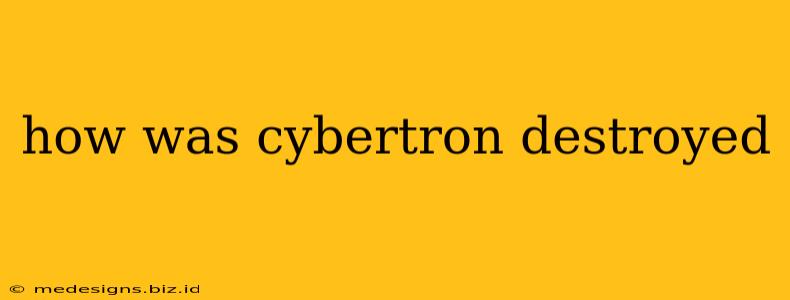The destruction of Cybertron, the homeworld of the Transformers, is a pivotal event in the franchise's lore, told and retold across various iterations of the story. While the specifics vary depending on the continuity (movie, cartoon, comic book, etc.), the core theme remains: a catastrophic conflict, fueled by internal strife and powerful weaponry, ultimately led to the planet's ruin. Let's delve into the various narratives and explore the common threads that weave through the tale of Cybertron's demise.
The Great War and its Devastating Consequences
The most consistent element across almost all continuities is the Great War. This brutal conflict pitted Autobots against Decepticons, fueled by ideological differences and a thirst for power. The war's intensity escalated dramatically, reaching a level of devastation that irrevocably altered Cybertron's fate.
Weaponry of Mass Destruction
The weaponry employed during the Great War was incredibly powerful, far beyond anything humanity has ever conceived. Planet-cracking weapons, capable of causing widespread geological upheaval and fracturing the very core of the planet, were deployed. This is a crucial element in explaining the planet's broken state. These weapons didn't just destroy cities; they shattered the very essence of Cybertron's integrity.
Energon Depletion and Environmental Collapse
Another contributing factor is the depletion of Energon, the lifeblood of Cybertron and its inhabitants. The war's relentless demands for Energon led to over-mining and environmental destruction, weakening the planet's core and contributing to its instability. The planet's systems, already stressed by the constant bombardment, were unable to recover from this resource depletion, further exacerbating the damage.
Variations in the Destruction Narrative
While the Great War is a common thread, the specifics of Cybertron's destruction vary. Here are some notable examples:
The Animated Series: A Slow, Grinding Decline
In the original Transformers animated series, Cybertron's destruction was depicted as a gradual process, the result of prolonged conflict and the planet's gradual decay, rather than a single cataclysmic event. The planet was slowly rendered uninhabitable, forcing the Transformers to flee in search of a new home.
The Michael Bay Movies: A More Explosive End
The Michael Bay films portray a more explosive end, with a direct assault leading to significant physical damage, including visible fracturing of the planet. The visual spectacle emphasizes the scale of the destruction, focusing on the raw power of the weaponry involved.
IDW Comics: A Complex Narrative
IDW's comics often explore more nuanced narratives, often weaving together various factors, including the Great War, the overuse of Energon, and the machinations of powerful individuals or factions, culminating in a multi-faceted destruction of the planet. These narratives often add layers of complexity to the existing lore.
The Legacy of a Fallen World
Regardless of the specifics, Cybertron's destruction serves as a powerful cautionary tale. It highlights the dangers of unchecked conflict, the devastating consequences of war, and the importance of resource management. The planet's fate serves as a constant reminder for the Transformers, driving their ongoing struggles and shaping their quests for a new beginning. The search for a new home, and the ongoing efforts to rebuild, become central themes in the various storylines.
Conclusion: A Continuously Evolving Story
The destruction of Cybertron isn't a static event; it's a pivotal moment in the ongoing narrative of the Transformers. Different iterations of the story add their own unique twists and interpretations, enriching the overall lore and providing a rich tapestry of possibilities for future explorations. Understanding the various narratives behind this devastating event offers a deeper appreciation for the complexities of the Transformers universe and the ongoing struggles of its inhabitants.
